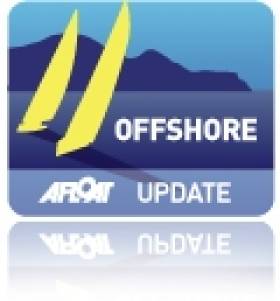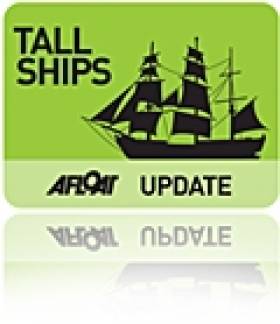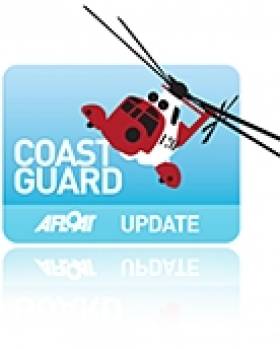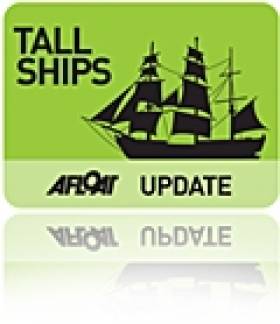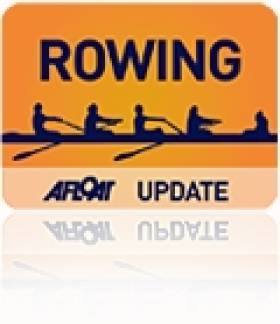Displaying items by tag: capsize
Walsh Capsize Ends Campaign at World Under-23 Rowing
#ROWING: Ireland’s Denise Walsh had an unfortunate end to her campaign in the World Under-23 Rowing Championships in Varese, Italy this morning. The Skibbereen woman ended up in the water at about 700 metres after a capsize in the repechage of the lightweight single sculls. Walsh was pushing for a top-two place, which would have put her in the semi-finals. New Zealand and Germany took these spots.
Video Shows Multi-Million-Dollar Yacht Capsize At Launch
#Capsize - The video above shows the heart-sinking moment when a $10 million yacht capsized during its launch in the United States' Pacific Northwest last month.
NBC News has more on the story of the explorer-type yacht Baden, which was being slowly lowered into the water from a ramp at Anacortes, north of Seattle in Washington state, when it began listing to port before suddenly dropping on its side.
The evidence so far suggests a problem with the dolly being used to launch the yacht, which has six people on board at the time of the incident. No injuries were reported.
Production has meanwhile been suspended by the yacht's builder, New World, which has also laid off its staff of some 50 workers.
Yacht Capsizes in Surf at Spanish Port of Zumaia
#capsize – A Bavaria 38 yacht, with seven crew on board, enters the narrow channel leading to the port of Zumaia on the Basque coast of Spain this month with dramatic consequences. 'The swell is of medium size, the operation is dangerous, but passable' according to local photographer Gabi Aymat who shot this dramatic capsize video.
A huge wave sweeps on to the boat and rolls it over knocking some of its untethered crew over board. The good news is that the crew survived and the boat is also safe, surviving its roll without any serious damage, according to Aymat.
#Mod70 – In the second dramatic capsize of a MOD70 trimaran – the first on Dublin Bay in June – French skipper JP Dick has been rescued by helicopter after his giant trimaran flipped in a training run.
In similar circumstances to the Dublin Bay capsize of Spindrift the Tri appears to have been blown over in a gust of wind. After the gust hits, the 70-footer sails along for several seconds on its leeward hull before finally capsizing, smashing its carbon mast as it fully inverts. One crew can be seen falling from the hull into the water.
Jean-Pierre Dick and Roland Jourdain were on board Virbac-PAPREC 70 off Belle Ile, practicing in 15-20 knots of wind for this month's Transatlantic Jacques Vabre race. According to reports from the professional French racing team the boat 'turned suddenly' and capsized. A Helicopter and lifeboat lifeboat retrieved the crew and boat. Below are vids from both the leeward side of the hull and from the rescue helicopter.
On June 22, the race-winning multihull Spindrift capsized in gale force winds off Dun Laoghaire at the start of the Route des Princes series of inshore racing spectacle on Dublin Bay.
That accident happened about 700 metres off the starting line as the fleet of five MOD 70s were accelerating in the strong and gusty winds. The boats were not carrying full sail as a precaution against the strong offshore winds blowing in the bay that day.
View from inside the leeward hull
Heli rescue - JP Dick injured
Astrid Repairs Unlikely As Experts Discuss Salvage Plans
#Astrid - The Irish Times reports that marine salvage experts met on Friday with insurers of the Dutch tall ship Astrid to determine a wreck removal plan for the sunken vessel.
The sail training ship, which was taking part in The Gathering Cruise around Ireland, capsized after hitting rocks inside the Sovereign Islands near Kinsale in Co Cork on the afternoon of Wednesday 24 July.
All 30 crew on board - including a number of teenage sail trainees - were brought to safety by RNLI lifeboats from Kinsale and Courtmacsherry in a major rescue operation.
As previously reported on Afloat.ie, investigations got under way last Thursday 25 July to determine what caused the 42-metre brig to run aground at the mouth of Oysterhaven harbour.
Despite strong winds and rough seas at the time of her foundering, the Astrid remains largely intact apart from rips along the hull.
And according to expert salvage diver Colm Harrington, the 95-year-old ship will be salvageable - using slings to lift the vessel from the water.
However, the severity of the damage sustained means that it's unlikely the Astrid will be restored to her former glory.
The Irish Times has much more on the story HERE.
Dinghy Capsize Prompts HM Coastguard Rescue of Five
Two adults and three children have been rescued from the water after their dinghy capsized off Gwbert, in North Wales.
Milford Haven Maritime Rescue Coordination Centre (MRCC) received a 999 call just after 11am reporting that a group of people were in the water yesterday morning.
The Cardigan Coastguard Rescue Team and the Cardigan RNLI inshore lifeboat were sent to the scene. The lifeboat located those in the water and managed to get them all on board. They were taken ashore where they were met by the Cardigan Coastguard Rescue Team and ambulance crews.
Bob Peel, Watch Manager at Milford Haven MRCC, said:
"The two adults and three children were well equipped as all were wearing lifejackets. They were rescued from the water uninjured, just cold and shaken from their ordeal.
"We always want people to have fun but stay safe when out on the water. That's why we always recommend to those heading out in a boat, canoe, kayak and such like, that they should wear an appropriate lifejacket or buoyancy aid. It's useless unless worn and could save your life."
Four RNLI Lifeboats Rescue Crew From Sunken Tall Ship Astrid
#TallShips - Four RNLI lifeboats were involved in the rescue of 30 crew from the tall ship Astrid, which sank off the Cork coast earlier today (Wednesday 24 July).
The 42m Dutch training vessel reportedly hit rocks inside the Sovereign Islands at Ballymacus Point, near Kinsale.
All on board were brought to safety when the Kinsale lifeboat transferred the casualties from the sinking ship onto the Courtmacsherry RNLI lifeboat and a local vessel. They were then taken to Kinsale.
Both Kinsale and Courtmacsherry RNLI lifeboats were called out at 12 noon today to go to the immediate aid of the sail training vessel that had got into difficulties on the western entrance to Kinsale Harbour in Cork.
Ballycotton and Crosshaven RNLI were also launched, though the Kinsale RNLI lifeboat was first on scene. There was a 2m swell and winds were force five to six.
The training vessel had lost power and was apparently driven on to rocks by a strong southerly wind at the western entrance to Kinsale Harbour. The grounded vessel was taking on water and a crewmember from Kinsale RNLI was put onboard.
Eighteen of the casualties were taken off the Astrid by Kinsale RNLI lifeboat and transferred to Courtmacsherry lifeboa, before being brought to safety. The remaining 12 were put onto a liferaft deployed by the Astrid’s crew, which was towed to safety by the Kinsale lifeboat and picked up by a local vessel.
The people on board the liferaft were then taken to Kinsale harbour and assessed by medical teams.
Irish Coast Guard helicopters from Waterford and Shannon were also on scene along with ambulances and medical crews from Cork.
Speaking about the call-out, Courtmacsherry RNLI coxswain Sean O’Farrell said: “Everyone was very fortunate. I want to praise the quick thinking of the skipper and the crew from the Astrid. They kept calm and did everything we asked them to do. We were able to get them to safety quickly and a major tragedy was averted. To be able to recover 30 people safely was a great day for everyone involved.”
Meanwhile, the Irish Sailing Association has issued the following media statement on behalf of the tall ship Astrid:
Tall Ship Astrid was on a voyage from Southampton to Cherbourg calling in to Kinsale. On board were 23 trainees from France, Ireland, the Netherlands, UK and Spain. The crew were from Belgium and the captain, Pieter de Kam was from the Netherlands.
As the Astrid was leaving Oysterhaven, as part of The Gathering Cruise parade of sail to Kinsale, the vessel experienced engine failure. They notified a nearby RIB which was being helmed by Irish Sailing Association (ISA) CEO Harry Hermon.
The RIB attempted to take a line from Astrid. However, due to the onshore winds and swell this was not possible. Captain de Kam issued a May Day.
The ISA RIB and the yachts in The Gathering Cruise flotilla stood by until the RNLI arrived. There was a safe rescue of all 30 crew who were brought to Kinsale on board the yacht Spirit of Oysterhaven and the lifeboat. All crew were brought to Kinsale Yacht Club where they were provided with showers, food and dry clothing. They were all medically checked and are in good health.
Sail Training Ireland and Kinsale Yacht Club are working together to make arrangements for accommodation and for returning the crew to their homes.
Commenting on the rescue, Captain Pieter de Kam of the Tall Ship Astrid stated: “I would like to thank the lifeboat and the coastguard for the safe rescue of all my crew. We very much appreciate their outstanding work.”
Harry Hermon, CEO of the Irish Sailing Association, commented: “It is thanks to the rescue services that all crew were rescued quickly and safely without injury. I would also like to thank all the sailors from the Gathering Cruise who stood by Astrid providing support to the crew.
"Kinsale Yacht Club has also been fantastic providing food and clothing and helping Sail Training Ireland find accommodation for all the crew”.
Fisherman Drowned 100 Metres From Shallows Says MCIB Report
#MCIB - Various factors - including poor buoyancy, suboptimal lifejackets and a fateful late decision to swim to shore - have been identified in the official report into the death of a fisherman off the Waterford coast earlier this year.
As previously reported on Afloat.ie, a major search and rescue operation was launched on 10 January when a 16-foot fishing punt capsized in a strong swell at the sandbar off Brownstown Head near Dunmore East, throwing its two-man crew overboard.
James Tate was able to swim to the nearby shore in the early morning darkness after some two hours in the water. But he became separated from his friend Johnny Flynn - a former member of the Dunmore East lifeboat crew - who was found unconscious in the water by coastguard helicopter before 8.30am.
Flynn was pronounced dead at Waterford Airport shortly after, with a post-mortem concluding that he cause of death was drowning.
The tragedy occurred six years to the day after the sinking of Dunmore East trawler the Pere Charles, which took five lives.
In the official report into the incident, the Marine Casualty Investigation Board (MCIB) found that the fishing punt, already vulnerable to breaking waves as an un-decked open boat, was more susceptible due to its waterlogged condition, and the lack of adequate buoyancy.
It was also found that neither the vessel's handheld VHF radio nor GPS device, or indeed Tate's mobile phone, were available to the pair after the boat turned turtle.
Though both men were wearing lifejackets, they were of a kind that lacked a collar that would have kept the deceased's head above water, nor did they have a light or whistle. Only Tate was equipped with any kind of light, so he could not locate his friend in the dark.
Most importantly, it was found that the boat had overturned within 100 metres of the shallows, so that if the pair had attempted to swim to shore earlier - rather than tire themselves out trying to climb onto the upturned hull - the chances of both men surviving the incident "would have been greatly enhanced".
The full report into the incident is available to download below.
#Spindrift - The race-winning multihull Spindrift has capsized in gale force winds off Dun Laoghaire this afternoon (22 June) at the start of the Route des Princes series of inshore racing spectacle on Dublin Bay, as David O'Brien reports on scene.
The MOD70 trimaran that was first into Dun Laoghaire from Lisbon on Wednesday capsized meres from spectators in Scotsman's Bay ahead of the first of three inshore races.
Rescue photos below.
The accident happened about 700 metres off the starting line in the first race, as the boats were accelerating in the strong and gusty winds. The boats were not carrying full sail as a precaution against the strong offshore winds blowing in the bay. Today's in–port racing was billed as 'fast and furious'.
At least one person is injured and is being treated upturned hull of the stricken craft. As of 3.08pm a rescue helicopter was dropping its winchman to the vessel.
It is feared by National Yacht Club personnel that the mast of the inverted trimaran is stuck in the sea bed and may be broken.
All racing has now been postponed as rescue services attended the scene. Eight crew were onboard the vessel at the time of the capsize.
Update 3.10pm: All other boats have returned to Dun Laoghaire Harbour as rescue services continue to attend to the capsized Spindrift and its crew.
Update 3.18pm: Weather conditions in Dun Laoghaire continue to be strong and gusty, and it's reported that some local DBSC RC racing had already been cancelled earlier today.
Update 3.27pm: A news update on the Route des Princes website (via @sailracewin) says one crewman on the upturned Spindrift has a back pain.
Update 3.35pm: Twitter users Mark Lloyd (@Lloyd_Images) and Philip Bromwell (@philipbromwell) have posted photos of the failed Spindrift in Dublin Bay as emergency services attend to the scene.
Update 3.39pm: The crewman casualty has been winched to the helicopter and is being airlifted to Tallaght Hospital. His condition remains unclear.
Update 3.41pm: Triage for any injured racers has been set up at the National Yacht Club and all rescue boats have been asked to report to the NYC to account for numbers.
Update 3.53pm: Assessments are currently being made as to how to recover the 70ft hull still floating north of Dalkey Island.
Update 4.04pm: Sailing journalist Kate Laven comments on Twitter re the Spindrift capsize: "Everyone recovered but two injured"
Update 4.08pm: The Route des Princes website has followed up its earlier update with a news post which confirms that weather conditions at the time of the Spindrift capsize were 20 knots with strong gusts.
Update 4.55pm: Dun Laoghaire lifeboat towing the upturned Spindrift hull (minus mast) towards Dun Laoghaire harbour
Update 6,00pm: The upturned hull has been successfully righted, the hull is intact but the mast is broken.
Update 7.00pm: There are unconfirmed reports that the injury to the Spindrift crew man is a broken pelvis.
Update 8.00pm: Spindrift racing team release statement on capsize and injury to crew member
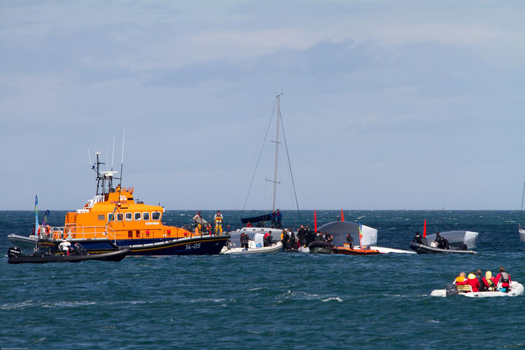
Rescue craft, local boats and the Dun Laoghaire lifeboat attend the upturned hull. Photo: Gareth Craig

The Coastguard helicopter arrives on scene and a winch man is lowered to make an assessment. Photo: Afloat.ie

Rescue personnel and Sprindrift crew on the upturned hull in Dublin Bay this afternoon. Photo: Afloat.ie
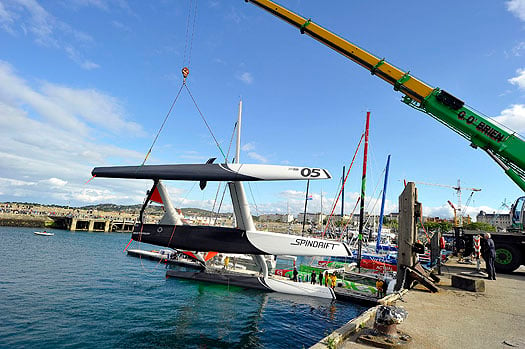
Spindrift minus her mast is lifted in Dun Laoghaire harbour this evening. Photo: Michael Chester
Rowers Rescued After Fisa Tour Hit by Squall on Shannon
# ROWING RESCUE: The Fisa Rowing Tour on the Shannon has been suspended a day before the scheduled finish after a number of boats were swamped during a squall on Lough Derg. Fourteen boats, which take a crew of five, were on the water at the time. All the rowers were accounted for and though some rowers were treated for hypothermia, none needed to go to hospital.
The full number on the tour, which is popular with retired people, was 101, but 31 had either taken the day off or were cycling alongside the Shannon.
The organisers were surprised to hear reports that 18 boats were “capsized” and that rowers did not have life jackets. “All rowers were wearing lifejackets or had access to them,” one of the main support personnel said. For a time one boat was thought to be missing, but the rowers were on land.





























